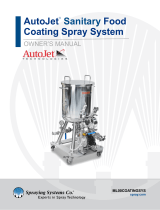
4
PRINCIPLES OF OPERATION
NOTE: The unit will only operate properly when mounted in
the vertical position (suspended or inverted).
The TankJet® 80 models are hydraulically driven rotating
heads that provides effective control of rotational speed to
assure optimum cleaning by the nozzle streams of internal
tank surfaces to be cleaned, sanitized, treated, or rinsed. No
reduction gears are used and therefore, minimal maintenance
is required. The nozzles will provide a complete 360° indexing
path in both vertical and horizontal planes, with the index
pattern repeating every 45 revolutions. The “clean line” design
of the TJ80H unit ensures a minimum of outside crevices in
the unit where processing material may accumulate to cause
contamination. It may be installed on a permanent basis (C.I.P.)
and can clean almost any type of contained area within its
range. Many types of fluids, sanitizers, detergents, solvents
and caustics may be used through the TankJet 80 to assist in
its cleaning effectiveness.
Caution: If chemicals, hazardous materials, operations,
and equipment are used in conjunction with this cleaning
equipment, it is the responsibility of the user to establish
appropriate associated safety and health practices. Prior
to application, the user must consult and determine the
applicability of regulatory (federal, state, local and facility)
safety and environmental agency limitations.
TANKJET 80H HYGENIC MODELS
SSCo. Part # Description
TJ80H*-2-250 Dual 1/4" Nozzles | 1.5" NPT
TJ80H*-2-313 Dual 5/16" Nozzles | 1.5" NPT
TJ80H*-2-375 Dual 3/8" Nozzle | 1.5" NPT
TJ80H*-2-438 Dual 7/16" Nozzle | 1.5" NPT
TJ80H*-3-250 Triple 1/4" Nozzles | 1.5" NPT
TJ80H*-3-313 Triple 5/16" Nozzle | 1.5" NPT
TJ80H*-3-375 Triple 3/8" Nozzle | 1.5" NPT
TJ80H*-3-438 Triple 7/16" Nozzle | 1.5" NPT
*Add B for BSPT connections after the model no.
MATERIALS:
316 Stainless Steel (UNS S31600), PTFE and UHMW-PE
CONSTRUCTION:
Referring to the Parts List, the unit consists of two basic
components; the drive, comprising of the body, motor, rotor,
and shaft; and the nozzle head, comprising of the nozzle body,
bushings, nozzles, and elbow shaft.
PRINCIPLE OF ROTATION:
The liquid enters the inlet cap (1) and then flows through
the oblique and bypass holes of the inlet disc (6) causing a
swirling motion in the liquid. The swirling liquid goes down
the outside of the vertical shaft (2) imparting rotation to the
4 tooth impeller (9) and thus the vertical shaft. The liquid then
goes thru the holes in the vertical shaft and thru the elbow to
the horizontal shaft (15). There is a hole in the elbow allowing
a constant stream of liquid to be directed at the gear mesh
to help prevent build-up. The liquid flows into the nozzle body
and out each nozzle. The rotation of the vertical shaft causes
the nozzle head assembly to rotate in a horizontal plane. The
water leakage from the bottom of the unit is necessary to
lubricate the vertical radial bearings and to flush out particles
which may cause the unit to jam. The nozzle bodies rotate in
the vertical plane by the meshing of the bevel gears (12 & 16);
bevel gear (12) has 45 teeth while bevel gear (16) has 44 teeth.
This difference in the number of teeth in each gear indexes the
nozzles with each rotation.
CLEANING DIAMETER:
The cleaning distance is a function of rotational speed and
liquid pressure applied. The effective cleaning diameter is
50 ft. (15.3 m). The nozzle extensions (22) concentrates the
stream for greater reach. If striping occurs on tank walls then
the extensions may be removed. This will provide a thicker
stream, but will sacrifice about a 10 ft. (3 m) diameter of throw.
Caution Pinch Point: Bevel gears on the nozzle hub and
body can pinch skin and/or fingers. When handling the
TankJet 80 be sure to hold it from the nozzles and not
the body.
TANKJET 80 MODELS
SSCo. Part # Description
TJ80*-2-375 Dual 3/8" Nozzle | 1.5" NPT
TJ80*-2-438 Dual 7/16" Nozzle | 1.5" NPT
TJ80*-2-438SR Dual 7/16" Nozzle | Slower
Rotations | 1.5" NPT
TJ80*-2-375CIP Standard | Dual 3/8" Nozzle |
CIP | 1.5" NPT
TJ80*-2-438CIP Dual 7/16" Nozzle | CIP | 1.5" NPT
TJ80*-3-375SR Triple 3/8" Nozzle | Slower Rotations |
1.5" NPT
TJ80*-3-375 Triple | 3/8" Nozzle | 1.5" NPT
TJ80*-3-313 Triple 5/16" Nozzle | 1.5" NPT
TJ80*-3-375SRCIP Triple 3/8" Nozzle | Slower Rotations CIP
| 1.5" NPT
TJ80*-3-313CIP Triple 5/16" Nozzle | CIP |
1.5" NPT
*Add B for BSPT connections after the model no.






















